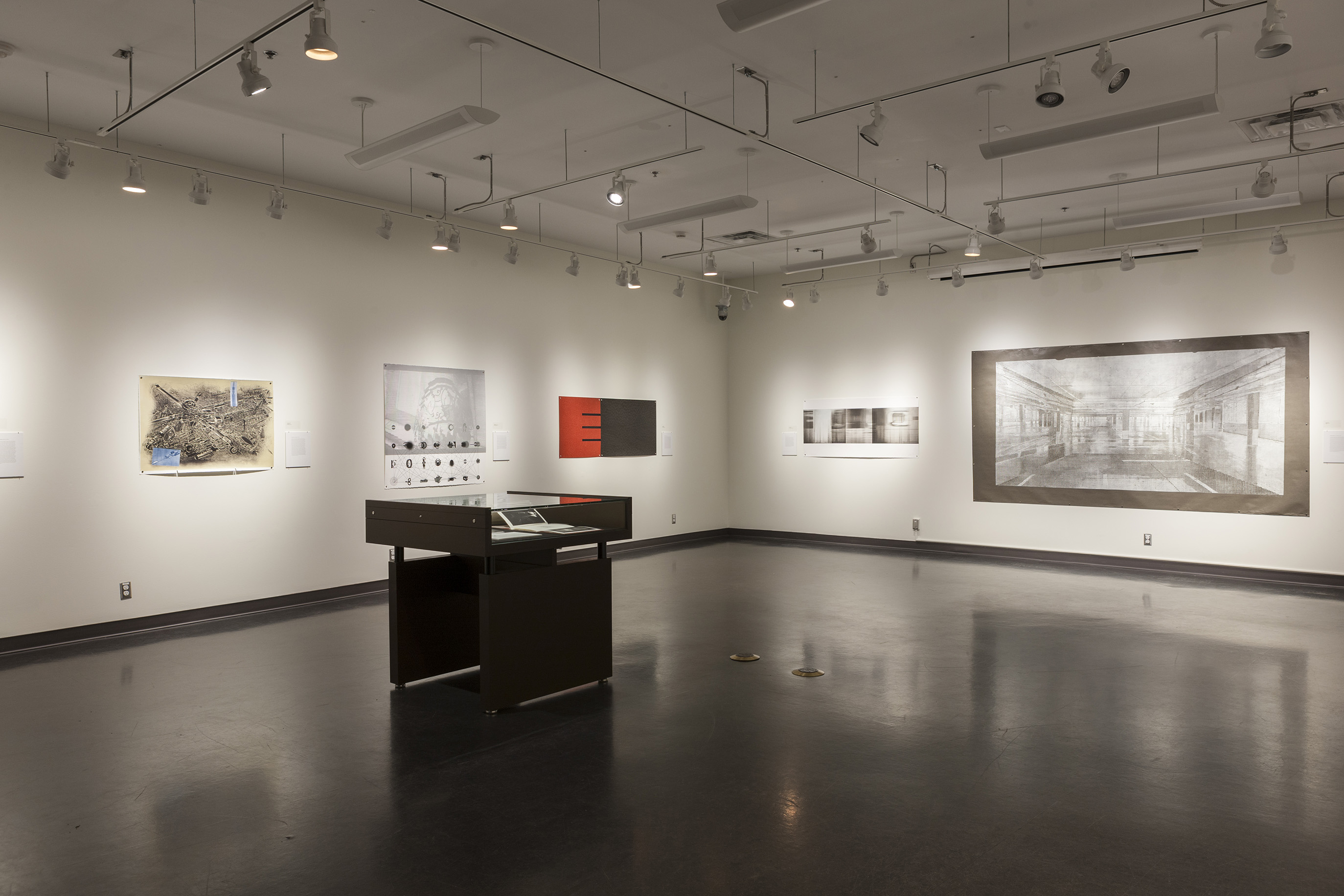
"Light/Matter" exhibition at UAlberta Museums Gallery A - TELUS Centre (Photo Courtesy of UAlberta Faculty of Arts)
While visiting the exhibition Light/Matter: Art at the Intersection of Photography and Printmaking the works of art on the walls might not come across as revolutionary. However, that is exactly what these prints are - they represent a technique in printmaking, one that utilizes photography in any shape and form, that has lived a strained existence with the rest of the printmaking world. This exhibition celebrates the photo-print technique and has a goal and a purpose to correct printmaking history.
Light/Matter contains nearly 100 works of art on paper by 40 artists from 16 different countries. The curators of this exhibition, Tracy Templeton, Ingrid Ledent and Walter Jule, reviewed the careers of over 1,000 artists in order to choose works of art for this exhibition. They were able to bring the list down to 40 individuals after taking a look at the artists' aesthetic and technical achievements and influence on the evolution of printmaking, among other criteria. All of the artists they asked to be in the show, accepted the invitation with enthusiasm.
"[There are] artists from around the world that have never been shown together. And yet, many of the artists in the show have been following each other's work for decades," said Jule. "[At the opening at Indiana University, artists] walked into the show and [would] see someone across the room and it was like a young jazz player being asked to blow with Miles Davis, suddenly they were with their heroes."
Why Light/Matter?
The title of the exhibition at first might seem abstract, but represents the messages of the exhibition in many ways. "It was almost simultaneous to the idea [of the exhibition]," explains Templeton, co-curator of the exhibition Light/Matter. They considered that in photography, light becomes matter - a photograph. The slash is used to represent a pause and interaction between the two stages.
"It's not just practical, but also poetic," admits Jule, another co-curator of this exhibition. "You have this light, this flicker and then you have to ground it on the plate and it becomes matter."
The exhibition, like light itself, covers a full spectrum of topics that will appeal to all types of audiences and not just printmakers.
"I think there is something here for absolutely everyone," says Templeton. "There is such a diversity of subject matter here … I think anybody could walk into this exhibit and have a relationship with a figure or a landscape."
Printmaking at the University of Alberta
"None of the artists that I spoke to were surprised that [the University of Alberta] was one of the venues because of the rich printmaking history," said Templeton.
In the early 1970s, three printmakers - Lyndal Osborne, Walter Jule and Liz Ingram - founded the printmaking program at the University of Alberta and helped it to become the first University in Canada to offer a master of fine arts program in printmaking.
"How could we differentiate ourselves at the University of Alberta?" Jule asks as he spoke about the early beginnings of the printmaking program at the university. "[At the University of Alberta] We wanted our students to be printmakers, not etchers and lithographers.… That was the mandate of our program that set us apart from every other school in Canada."
In 1996, the University of Alberta Museums opened the Print Study Centre in the Fine Arts Building and since then, has welcomed in international printmakers and researchers who have collaborated and contributed to the works found in the Print Study Centre and the University of Alberta Art Collection.
"It wasn't enough to introduce photography into printmaking [in the courses], we thought we had to seek out … pioneers in the field and bring them to the U of A," added Jule.
Many of the artists featured in the exhibition, for example Japanese printmaker Ryoji Ikeda, created their works of art at the University of Alberta while they were visiting and working with the printmaking program. Their works of art have since been included in the University of Alberta's Art Collection.
Photography in Printmaking
"Even though printmaking and photography were joined at the hip at birth, the relationship has always been uneasy," explains Jule. "So it's been [a relationship] of excitement and antagonism at the same time and it's still going on." The seamless integration of photography and printmaking in the works of art on display in Light/Matter make you think that photography and printmaking have always been used in combination with one another. But this is not the case. There are international competitions and exhibitions that distance themselves from any hints of photography in the works of art they showcase.
"They are worried about severing printmaking from it's historical origins," said Jule about this struggle. "I think this exhibition will prove that that separation [of photography and printmaking] happened a long time ago … they've grown up and now they've come back together, they have a lot to offer each other."
Light/Matter showcases the combination of printmaking and photography as it proves it's point - these works of art are timeless and represent an international movement that has never had the opportunity to be in the spotlight. Light/Matter is seen as an opportunity to give photo printmaking it's time to shine.
"[Photo printmaking is a] global internationally inspired invention that was happening all across the world at the same time," said Jule. "We're trying to correct history by showing how artists from that period until today are continuing to integrate analog and photographic techniques to explore new kinds of images."
Light/Matter: Art at the Intersection of Photography and Printmaking is open until June 2 in the University of Alberta Museums Gallery A (TELUS Centre) and FAB Gallery. Admission is free.